On the basis of bombers
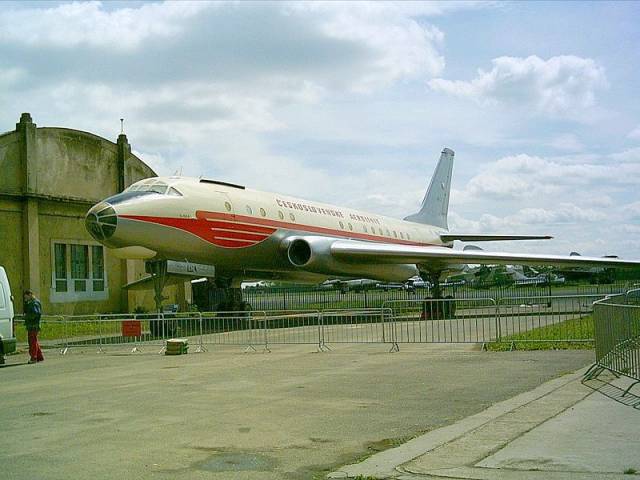
After the end of the First World War and a massive reduction in the arsenals of the air armies of the winning countries, these machines were out of work. Naturally, the question arose about their further use for the delivery of goods and passengers. There were projects of adaptation and alteration of heavy combat vehicles for civilian purposes. From the very beginning of this process, there have been two paths. The first path was to create transport vehicles due to minimal rework of basic combat vehicles — dismantling bomber and defensive small arms systems from an aircraft, adjusting the released internal fuselage volumes for equipment for transporting goods or people.
This path gave the maximum savings in the alterations of basic aircraft, but did not allow to get in operation a sufficiently economically viable transport aircraft due to the limited size and fuselage volumes used. The second path consisted in a radical alteration of the basic design of the bomber aircraft by designing a new fuselage with increased dimensions and more adapted for the delivery of goods and passengers. At the same time, the design of the wing, the power plant and the composition of the flight equipment remained virtually unchanged.
In both cases, the great advantage was the ability to use trained combat crews aviation, practically without retraining, as well as the use of the technical reserve of the aviation industry for basic military aircraft for the operation and improvement of aircraft, but in a new, civilian quality.
All this allowed, to a certain extent, at the first stage after the end of the war, to saturate the market of nascent aviation services with passenger aircraft, up to the moment when more technically and economically improved passenger aircraft, originally designed for civilian purposes, appeared.
It should be noted that these two directions of use of bomber aircraft have been preserved throughout the past century, and it was especially vividly manifested after the end of the next world massacre, as well as in countries with high militarization of the aviation industry, in particular, in the USSR, where the creation of civil aviation aircraft was a matter of the second order.
Most vividly, the “secondary” trend in the creation of aircraft for the Civil Air Fleet is traced in the activities of Andrey Nikolaevich Tupolev. The first type of military aircraft developed by its OKB, adapted for civilian purposes, was the light reconnaissance bomber P-3 (ANT-3). The development of this modification, hereinafter referred to as PS-3, began in early March of the 1928 year. It was then that TsAGI came up with a proposal to use serial P-3 to transport mail after the necessary structural alterations to the observer's cabin.
The proposal was accepted, and the first "demilitarized" aircraft P-3 M-5 (PS-3) was sent in 1929 for operation on the Moscow-Irkutsk mail line. In total, three dozen reconnaissance aircraft P-3 were re-equipped, which were operated in the Civil Air Fleet system until the 1933 year. In the second half of the 30s, as the Air Force was decommissioned, disarmed TB-1 heavy bomber aircraft, designated as G-1 in the Civil Air Fleet, began to enter the Civil Air Fleet as transport planes.
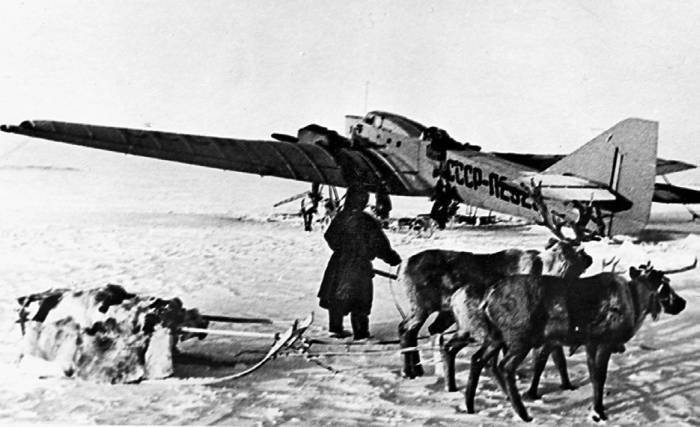
As a transport aircraft, the cars showed miracles of longevity, working mainly on the northern routes, flying off the entire Great Patriotic War, flying both in the rear and in the front line. The last G-1 worked in the north before the 1948 year. Similarly, the four-engine TB-3 converted into “trucks” was used as a “truck” in the structure of the units of the Civil Air Fleet, while in the Civil Air Fleet, the G-2 was used. These machines laid a heavy load during the war years for the transport of emergency national economic and defense cargoes throughout the country.
In 30-e, Aeroflot began to receive PS-7 and MP-6 aircraft, which were civilian versions of the P-6 (ANT-7) multipurpose military aircraft. The aircraft in the land and float versions for a long time used in the eastern and arctic regions of the country.
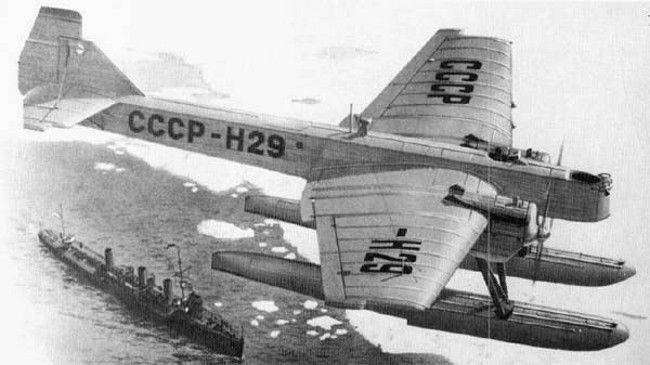
High-speed mail and cargo planes PS-30 and PS-40, converted from the SS high-speed bombers (ANT-41), became widespread at the very end of 40-ies and during the war in Soviet civil aviation.
In 1936, the OKB was designing a passenger version of the MDR-4 (ANT-27). In August 1935 of the year, the design bureau on the request of SUAI began designing a passenger version of the sea heavy bomber MTB-2 (ANT-44), designed to carry more than one and a half tons of payload. It included 10-15 passengers with luggage and more than half a ton of cargo and mail. All these projects of civilian flying boats have not gone beyond the stage of initial technical studies and technical proposals. Similar work was carried out on the project MK-1 (ANT-22).
In 20 and 30, in addition to solving the issues of "demilitarization" of production military aircraft, the Design Bureau created several all-metal passenger aircraft, in the design of which the units and technologies mastered in the series of combat Tupolev vehicles were widely used. In 1929, the first flight of a three-engine, nine-seat passenger ANT-9, the wing of which used the P-6 consoles, was used for the first flight. It was built in a rather large series for its time and was in operation for a long time (the last car flew up to the 1946 year).
Later, in the course of modernization, they switched over to the two-engine scheme of the aircraft, the power plant of which was entirely taken from the P-6. In total, about 75 machines of the ANT-9 type were manufactured, mainly twin-engine versions were in operation. When building the first domestic multi-seat five-engine passenger aircraft ANT-14 (32-36 passengers), used constructive elements and units TB-3 were used. In addition, at the end of the 20-s, the Tupolev people conducted preliminary work on the TB-19 passenger ANT-1 project with a new enlarged fuselage and passenger compartment.
In 1932, TsAGI resolved the creation and launch into mass production of the passenger version of the heavy six-engine bomber TB-4 (ANT-16). In the future, the units of the experienced TB-4 “doubler” were used to build the “Maxim Gorky” propaganda ANT-20, designed to carry 72 passengers. Its development was ANT-20bis (PS-124). He became the first aircraft, the proposed series of these giant machines, was calculated on the transport of 60 people. PS-124 was sent to operation in the Civil Air Fleet and worked on Aeroflot lines until 1942.
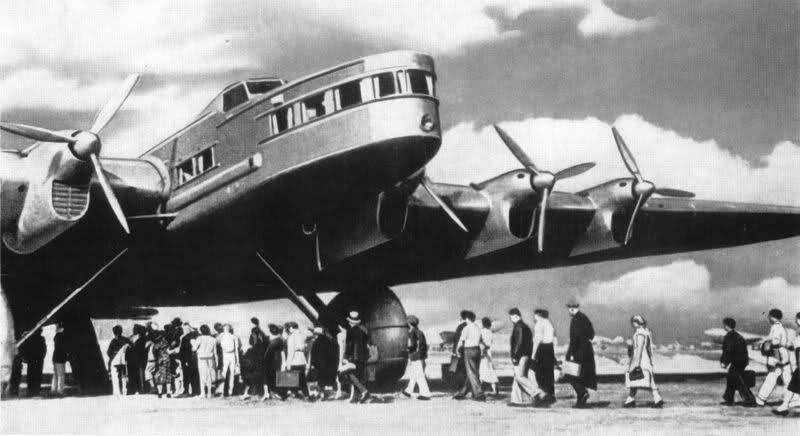
The 30s have been marked by a significant improvement in the aircraft’s technical data due to more advanced aerodynamic, layout and technological solutions. These include, first of all, the final transition to the scheme of a cantilever monoplane with a smooth casing with retractable landing gear, improvement of the specific and absolute parameters of the engines, improvement of the onboard equipment.
The creation of the SB high-speed bomber was in many ways a constructive and technological base for the passenger PS-35 (ANT-35), which made its first flight in the 1936 year and launched in a small series. At the end of the 30-s and during the war years, the PS-35 in the version for carrying 10 passengers was successfully operated on domestic airlines.
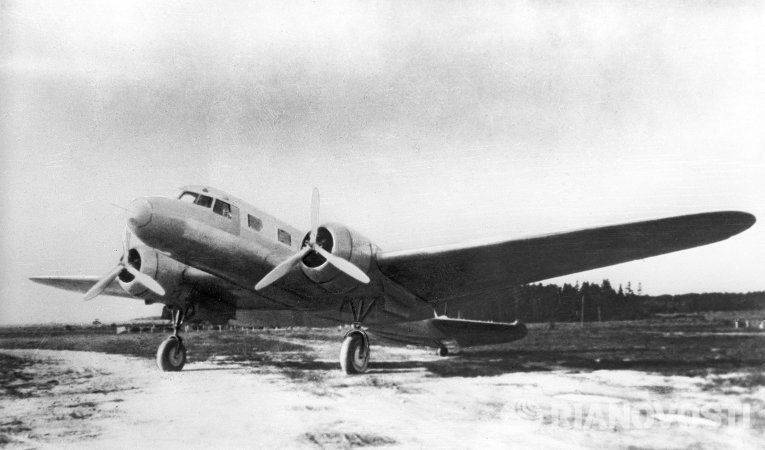
Work on the torpedo bomber T-1 (ANT-41) stimulated the design of high-speed twin-engine passenger ANT-50. Successful work on the heavy TB-7 project (ANT-42) in the second half of the 30-s allowed to begin designing the first Soviet airliner ANT-53 - a four-engine aircraft with a passenger pressurized cabin. Its construction should have used elements from TB-7.
The concept of the ANT-53 project was in many respects identical to the American four-engine passenger aircraft “Boeing 307”, which was based on the design solutions of the B-17 bomber. Unfortunately, the projects ANT-50 and ANT-53 were not made.
When designing the TB-7, the developers were given the task of creating a civilian aircraft based on the bomber developed in the series. In the passenger version of the ANT-42 was calculated to carry about three or four dozen passengers (in any case, in the landing version it was intended to transport 50 paratroopers). For the implementation of the construction of a passenger car in a mixed series (bomber + passenger plane), the maximum unification of the fuselage was proposed, which allowed a relatively painless transition during serial construction from one version to another. Given these requirements, the first two prototypes were released. When introduced into the series, passenger unification is partially rejected. The central part of the fuselage is crimped midsection, its shape is aligned for the sake of aerodynamics, the side windows are significantly reduced, the glazing area now could only satisfy the unpretentious Red Army paratroopers, and not passengers, by definition, especially the special flights.
In 1942, the Soviet Union's Commissar for Foreign Affairs V.M. Molotov with a TB-7 serial bomber made a special veil to Washington with transit landings in Scotland, the Faroe Islands, Iceland, Canada, and then back to Moscow through New Fawnland, Greenland, Iceland and Scotland.
To some extent, this flight intensified interest in creating a passenger plane for special flights based on the Pe-8 and other serial bombers. The People's Commissar of the Aviation Industry sets before the Special Design Bureau I. Nezval the task of re-equipping several Pe-8 bombers for long-haul flights of a small number of passengers, while retaining the entire composition of defensive weapons (taking into account the experience of flying a Molotov airplane over territories occupied or controlled by the enemy's air force).
The design and conversion of four Pe-8 with ACh-Gob diesel engines to a modification for special transportations on 14 passengers, three of them were set. Quickly enough, the OKB prepared the necessary design documentation for this. Four aircraft 12 of the final series Pe-8 were subject to conversion. Later, the machine was assigned the code Pe-80H.
The main differences from the serial bomber consisted in the following structural elements. Glider aircraft consistent with the serial Pe-8. In the fuselage, in the center section between the first and second spars, a cabin for 2-3 was equipped with berths and one passenger cabin for 12 seats. The plane was installed vertical tail of a larger area, with a developed forkil. The engines of the serial ASH-82 aircraft were replaced with diesel engines ACh-ZOB with power up to 1500 hp. Screws of a new type were installed with a wind vane position of the blades and electro-hydraulic control of the transfer of screws to this position. Installed heating and ventilation of passenger cabins, defrosters such as "Goodrich" on the wing and tail. There was an oxygen equipment for passengers of the "Pulmonary machine". The top fuselage shooting installation "TAT" was shot.
The tests of the converted aircraft began in the winter of the year 1945. Flight tests were carried out by the crew of the serial plant No. 22 headed by V. Govorov. In total, during the factory tests, 6 flights were performed, in which the maneuverability and controllability of the aircraft, the operation of the anti-icing system, heating and ventilation of the passenger cabin were checked, and shooting was carried out weapons, new propellers were tested, speeds and rate of climb were determined at various engine operating modes by altitude, ceiling, fuel consumption at altitude.
During the tests with a take-off weight of 30000 kg and an altitude of 6000 m, the maximum speed of 421 km / h was reached, the climb rate to 4000 m was within 5,1 — 4, 7 m / s. Fuel consumption at altitude 4 km and speed 300 — 330 km / h - within 1,5-1,6 kg / km. The tests of the aircraft ended at the end of February 1945-th. The conclusion of the tests, taking into account some comments on the engines and the passenger compartment, was generally positive. It pointed out the advantages of diesel engines in comparison with gasoline engines in operation, there was an increase in flight range in comparison with engines ASH-82.
In conclusion, it was said that the comfortable equipment of the passenger cabin, the availability of berths allow passengers to safely carry long flights with rest on the way.
While the tests were underway, the Pe-80Н Pe-up was completed. When working on it took into account the results of tests of the first machine. At the end of winter 1945, the flights of the "double" began. However, during the operation of these aircraft were not used for its intended purpose.
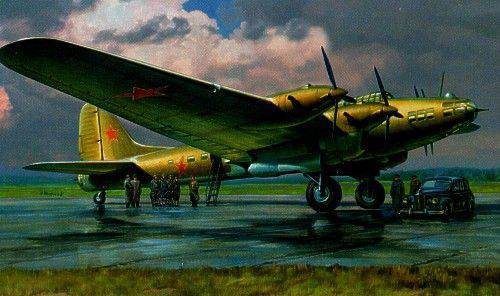
In addition to work on the Pe-80H, the OKB Nezval, in 1945, the beginning of the development on the basis of the Pe-8 of a passenger plane on the 50 seats (aircraft "E"). The aircraft was designed for engines ASH-82FN, in the first half of 1945, the project was presented, general views, plazas and working drawings for the tail assembly and landing gear were worked out. The overall design readiness by the middle of 1945 for the project was 20%.
In July, after the transfer of the OKB Nezval on the subject B-1945 (Tu-4) to 4, all work on the topic was stopped, simultaneously with the cessation of work on the promising heavy long-range bomber.
At the end of 1943, the Tupolev people began work on a new long-range high-speed bomber, which received the cipher "64". Almost simultaneously with the work on the bomber in the bureau began work on its passenger version - "66". Both the bomber and passenger projects were developed taking into account the maximum unification of the structure. Changes of the bomber variant in the serial construction to the passenger one were carried out by the following transformations of the “sixty-four” structure: the central part of the fuselage changed; center-section down to half a meter; Above the wing in the fuselage was obtained a free passage and an area for two bathrooms; the place of bomb compartments was sealed, forming a common passenger cabin. Such modifications were envisaged in the design of the base bomber, which ensured the simultaneous serial production of both variants or the rapid conversion of one to another. The possibility of processing the passenger version into a transport one (in case of military need) into an airborne and sanitary one was taken into account. It was possible to install equipment for turning the machine into a towboat of large landing gliders. All these options could be used for defensive armament.
The overall dimensions of the "sixty-six" coincided with those of the 64 bomber. The calculated flight characteristics with the AM-43ТК-300Б engines of the 66 aircraft were close to the data of the 64 bomber project. But the work on "66-mu" were curtailed simultaneously with the development of the basic version.
In addition to this project, in 1945, an engineer of the OKB N.V. Kirsanov (in the future, the chief designer of the Tu-142 and Tu-95MS) proposed a project of reworking an experienced long-range bomber "62" (Tu-2D) into a passenger for special transportation, designed for 15-20 people.
In the first half of 1946, Tupolev proceeded to design, on the basis of the B-4 bomber, a four-engined passenger aircraft with a pressurized cabin that would meet the highest international requirements for long-haul liners.
This machine received the cipher "70" by KB. By the spring of 1946, the production of a model of the new aircraft began. In order to accelerate the production of the first prototype used units of two B-29 bombers. They took wing consoles, engine nacelles, landing gear, tail assembly units and equipment. The hermetic and central wing was re-developed (the plane became a low plane). On the "70-m", compared with the B-4, used a more rational stepped shape of the cockpit.
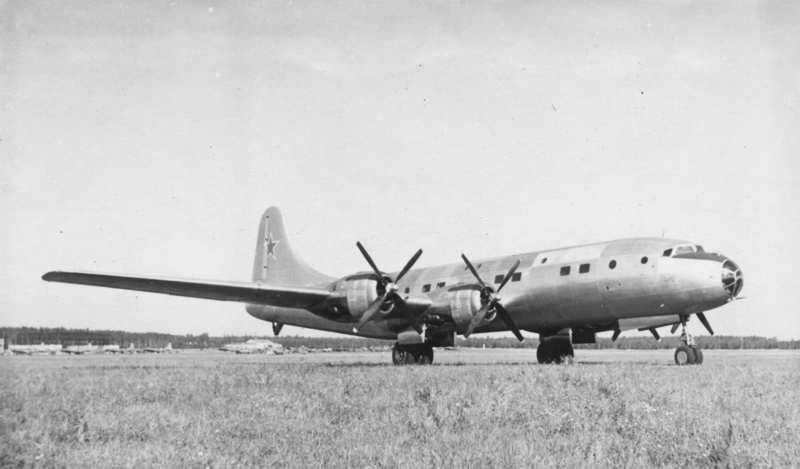
According to the project, the "seventies" was a passenger airliner destined for domestic long-distance and international flights, including trans-oceanic. Construction was planned in 3-x variants: a special government; in mixed - on 40-48 seats; Linear- at 72 locations.
In the fall of 1946, the aircraft was built and handed over for testing. In the fourth test flight, the airliner made an emergency landing and was damaged. In flight, one motor collapsed, causing a fire. Test pilot Opadchiy, saved an experienced specimen, having managed to land the car with the chassis retracted.
A detailed investigation of the incident revealed a serious structural defect in the American version of the turbo-compressor system control used. By the way, it was this structural defect that caused the death of the first prototype of the B-29 during tests in the United States. Americans could not find this defect. In December 1947, state tests were completed.
In June, 1948 of the year issued a decree on the construction of a series of Tu-20 aircraft in 70. However, a series of passenger aircraft is not set. The reason was the loading of production plants by the release of the B-4 bomber. And most importantly - the passenger traffic on the Soviet airlines of that time did not require such a large airliner. Aeroflot had enough capacity Li-2 and IL-12.
The creation in the country at the beginning of the 50-ies of heavy long-range bombers, equipped with turbo-jets and turboprop propulsion systems, made it possible to begin the development of the first Soviet jet passenger aircraft.
When creating these firstborn, the leading design bureau countries went in different ways: design bureau S.V. Ilyushin relied on the design of a completely new aircraft, which did not have a military prototype at its core, considering that this was the only way to get a cost-effective machine. This direction led to the creation of a successful medium-haul IL-18 with theater.
OKB OK Antonova was engaged in designing on the basis of a common unified constructive base of two aircraft - the military transport An-12 and the passenger An-10, which had a large number of common structural units and assemblies.
OKB A.N. Tupolev went the usual way. Using the experience of the creation and design elements of the Tu-16 aircraft, the Tupolevs in a short time created the first Soviet jet aircraft Tu-104, the introduction of which into operation caused a real revolution. Then, based on the strategic bomber Tu-95, the Tu-114 was created - the first domestic intercontinental passenger aircraft.
Aware of the complexity of developing a new passenger jet engine from scratch, A.N. In 1953, Tupolev addressed the government with the proposal to create the first Soviet airliner with a turbojet engine based on the Tu-16 bomber. According to the estimates of the OKB, it was necessary to increase the service life of the jet aircraft to 25000 flight hours (piston had 10000 hours) to improve efficiency; Increase the payload by creating cars on the 60-100 passenger seats; to increase the cruise speed by increasing the cruising speed to 760-850 km / h.
The main economic effect, according to Tupolev, was to provide an evolutionary path for the creation of a civilian aircraft based on the Tu-16 bomber, which was the main focus of the report. The experience of creating and operating a military aircraft was fully used, which made it possible to rely on the high reliability and safety of operation required for a passenger aircraft.
The costs of introduction into the series were reduced, which reduced the cost and increased its economic characteristics; the problems of training pilots and ground personnel were greatly facilitated by attracting specialists who had training in the Air Force.
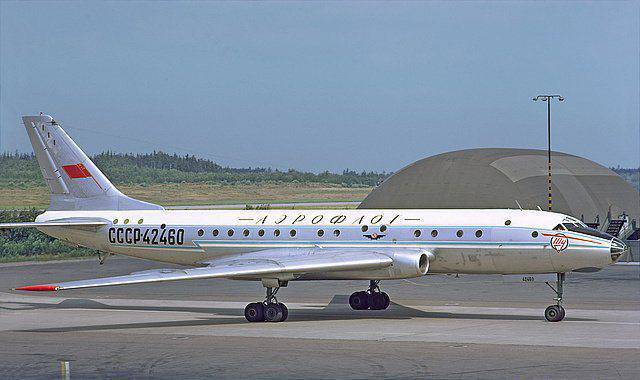
Changes to the Tu-104 from the Tu-16 were made by replacing the fuselage with a new, increased by 0,6 m diameter from the pressurized cabin from nose to tail unit. The layout of the aircraft was changing: instead of the mid-plane, it became a low plane, therefore the center plane with engine nacelles was re-designed as well. Detachable wing consoles, landing gear, gondolas of the main landing gear and tail assembly were used from the bomber.
At the end of the summer 1954, the draft design of the Tu-104 was ready. At the same time, detailed design and construction of the experimental machine was carried out. In June, the 1955 began flight tests of a prototype machine.
Simultaneously with the factory testing was preparing for the launch of the Tu-104 in the series. And just a year after the government decree produced the first production machine.
15 September 1956-th Tu-104 performed its first regular flight from Moscow to Irkutsk. October 12 opened international flights to Prague. Active machine operation began, marking a new era not only in domestic passenger aviation, but also influencing the development of world civil aviation.
In a series of Tu-104 repeatedly modified. AM-3 engines have replaced more economical RD-3, RD-ЗМ and РД-ЗМ-500. Options were prepared with an increased number of passenger seats. Continuously updated all sorts of equipment. There are about twenty modifications of the Tu-104. From 1957 to 1960, 26 set world records for speed and capacity on its various modifications, more than on any other jet passenger plane in the world.
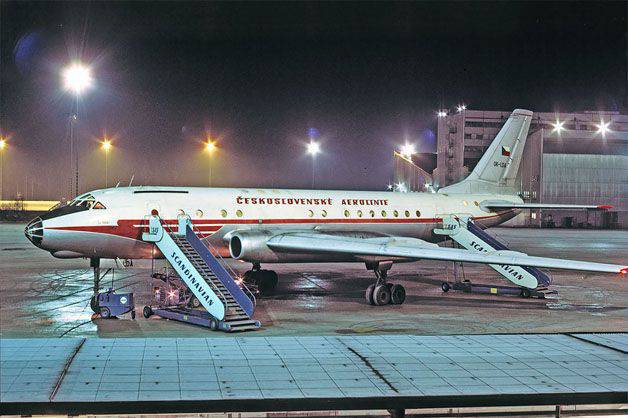
The massive operation of the Tu-104 continued until the end of the 1979 year. But for a long time, it was exploited in the interests of civil and military organizations. For 23, the Tu-104 aircraft carried about 100 million people, flying 2 million flight hours in the air and making 600 thousand flights. Tu-104 prepared the domestic CAF for the operation of next-generation jet airliners.
The launch of the intercontinental Tu-95 series enabled the OKB to start developing a passenger Tu-114 on its basis. According to the decision of the chief designer, subsequently all passenger aircraft of the OKB A.N. Tupolev, should have been assigned a cipher ending in a “four”. Work on the machine started in the spring of the year 1955. Like the work on the Tu-104, during the transition from the Tu-95 to the "one hundred and fourteenth", the aircraft layout was changed, it became a low plane, the center section changed, and the passenger compartment fuselage was developed anew. The plane of the wing, the main chassis, tail, power plant, many items of equipment remained the same.
By the summer of 1957, a prototype Tu-114 "Russia" was manufactured and submitted for testing. A year later, the first production Tu-114 was launched. Until March 1961, the new machine passed operational tests. In April, the first flight Moscow - Khabarovsk was completed on it, the Tu-114 became for many years the flagship of our civilian fleet.
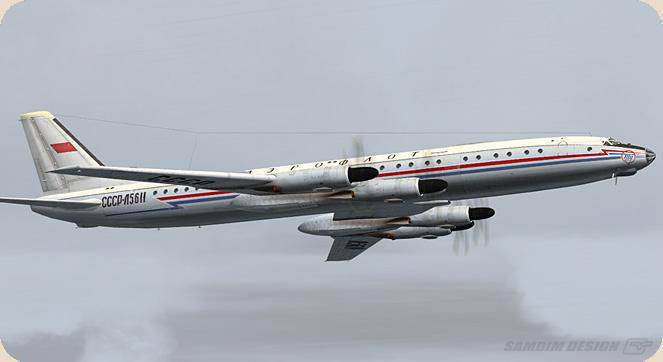
At the aircraft factory №18, the production of a new airliner began with 1959. A total of 1965 built the 31 serial machine. The aircraft was produced in two versions - on 172 and 200 seats.
There are up to ten different modifications of the Tu-114. This airliner was one of the most economical aircraft used on long-haul routes. Fuel consumption was only 34 g / pass-km. Over the 15-year operation period, the “hundred and fourteen” carried out about 50 thousand flights and delivered more than 6 million passengers. The airliner has established itself as an unusually reliable aircraft. For all the years of the flights there was the only disaster that occurred during the takeoff at Sheremetyevo airport in 1966. But it was also caused by a violation of the rules of operation.
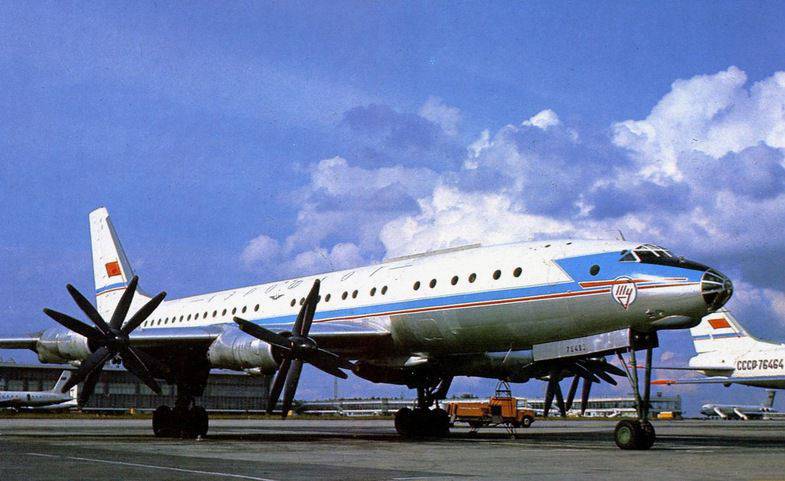
Tu-114 initiated the active development of ultra-long international routes. In 1959, the flight of N.S. Khrushchev in the United States. In the summer of 1962, a technical flight was made to Havana with a transit landing at Conakry, later regular flights to Cuba were carried out across the North Atlantic with a transit landing near Murmansk. In 1966, flights to Tokyo began, and in October to Montreal.
In the 1961-1962, on the Tu-114, the crews of I. Sukhomlyn and A. Yakimov set the 32 world record for range, speed and altitude.
At the very beginning of the development of the Tu-114, the OKB was assigned the task of converting two Tu-95 bombers into special-purpose passenger vehicles. The design bureau received the cipher "116" or official - Tu-116, in open sources the plane was called Tu-114D ("D" is diplomatic).
In the first half of the 50-ies, the Tupolev Design Bureau began designing new-generation heavy jet combat aircraft capable of developing supersonic speeds. The result was the creation and transfer to the series at the end of 50-ies of the long-range supersonic Tu-22 bomber and Tu-128 interceptor, as well as the elaboration of promising projects of the 106, 108, 109 and XNUM supersonic attack aircraft ". These works on combat aircraft became the basis for the OKB to search for optimal ways and approaches in creating the future Tu-135 - the world's first supersonic passenger aircraft.
The works were carried out according to the usual scheme for Tupolev: the design of a combat vehicle was taken as a basis and a passenger version was worked out at its base. This work received the code "134" (Tu-134). At the initial stage, the development was carried out on the basis of the project of the 105А bomber (Tu-22), and then they took the 106 aircraft for the basic model.
In particular, one of the variants of the 106 project, the 106A aircraft with engines in wing nacelles, was considered and, on its basis, the department prepared the 134 machine projects with the NK-6 TRD or VD-19Р2. In the 1962 year, at the suggestion of the MAP, the OKB conducted preliminary work on a supersonic passenger aircraft developed on the basis of the intercontinental single-mode supersonic Tu-135 project, which had been developed at the OKB since 1958. The passenger Tu-135P was planned to be equipped with four NK-135 engines (the civilian version of the military NK-6) and was intended for flights at speed M = 2 at a distance of 6000-6500 km.
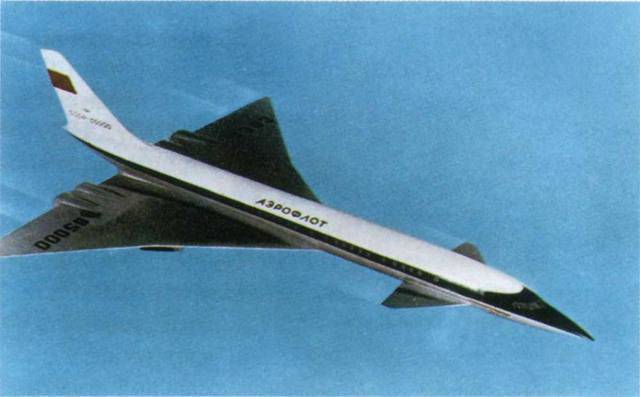
Tu-135P became one of the preliminary projects on the program to create the future Tu-144, the design of which was officially set by the OKB a year later, in 1963.
From 1962, the Ilyushin Design Bureau began work on the new long-haul IL-62, which was later replaced by the Tu-114. In 1963, the Tupolev Design Bureau began designing a medium-haul passenger Tu-154, a new-generation vehicle, the first passenger aircraft of the Design Bureau, which did not have a military prototype at its core. In the 1968, the Tu-154 began to pass tests, and from the beginning of the 70-s entered service, gradually displacing the first-generation jet passenger vehicles of the first generation Tu-104 and Il-18 from the GVF fleet.
All subsequent promising programs of the OKB for passenger aircraft were also based on original projects that did not have military prototypes.
However, 90-s in the conditions of certain changes in the economic life of the new Russia ASTC them. A.N. Tupolev stubbornly sought new ways to develop their aviation programs. The sharp reduction in the military sector orders for new aviation technology has increased the interest of management and developers to non-traditional OKB samples of civil aviation equipment, as well as to conversion programs.
Hence the appearance in the 90 of the projects of several administrative aircraft, which led to the creation of a regional Tu-324. The development of the base Tu-204 family towards creating a whole range of vehicles of various classes and purposes, the emergence of projects of long-haul passenger aircraft of large and extra-large passenger capacity, cargo aircraft of various classes.
In the field of conversion programs at the beginning of the 90-ies, with the participation of the OKB, work was carried out on the conversion of the serial anti-submarine Tu-142М and Tu-142МЗ into economical transport machines for transporting cargo and fuel. For civilian use (in particular, for environmental monitoring), the Design Bureau proposes to use the Reis-D unmanned reconnaissance complex (Tu-243). As the first stage for the launch of commercial satellites, the OKB worked out an aviation-missile system based on a multi-mode rocket carrier Tu-160.
At the end of 90-s, the chief designer on the subject of supersonic passenger aircraft is A.L. Pukhov, together with A.A. Pukhov was presented to the management of the company a technical project for the conversion of a multi-mode production rocket carrier Tu-22МЗ into an administrative passenger Tu-344. In the course of considering the possibility of creating such a modification, several transformations of the basic design of the Tu-22МЗ were considered. In variant “A”, it was proposed to place 10 passengers in the cabin at the place of the aircraft's cargo compartment. Option “B” dealt with a deeper processing of the basic design with alteration of the fuselage in the center section, taking into account the placement of passengers up to 24-30. In option “C” it is proposed to accommodate passengers up to 12 behind the cockpit.
Compared with the base model of the Tu-22MZ, the fuel stock is increasing and the design of the center-fuselage section is being finalized. The subsonic Tu-344 flight range was planned to 7700 km. At this work on the transformation of military versions of aircraft into civilian cars in the Tupolev Design Bureau ended.
Sources:
Rigmant V. Under the signs "ANT" and "Tu" // Aviation and Cosmonautics. 1998. No.4. C. 55-56.
Rigmant V. Under the signs "ANT" and "Tu" // Aviation and Cosmonautics. 1999. No.7. C. 42-45.
Yakubovich N. The first passenger jet // Wings of the Motherland. 1998. No.2. C.1-12.
Gordon E., Rigmant V. Flagship // Aviation and Time. 1999. No.3. C. 25-28.
Vulfov A. "Snake-Gorynych" // Aviation and Cosmonautics. 1999. No.9. C. 18-25.
Smirnov U. "Family" Tupolev aircraft // Wings of the Motherland. 2001. No.6. C. 12-15.
Rigmant V. Hailing from long-range aviation // Wings of the Motherland. 2000. No.10. C. 7-11.
Kotelnikov V. “And who said that crocodiles do not fly?” Passenger aircraft ANT-9 // Aviamaster. 2004. No.3. C.17-19.
Shavrov V. History designs of aircraft in the USSR to 1938, Moscow: Mashinostroenie, 1985. C. 403, 404-406, 499-500, 619-624.
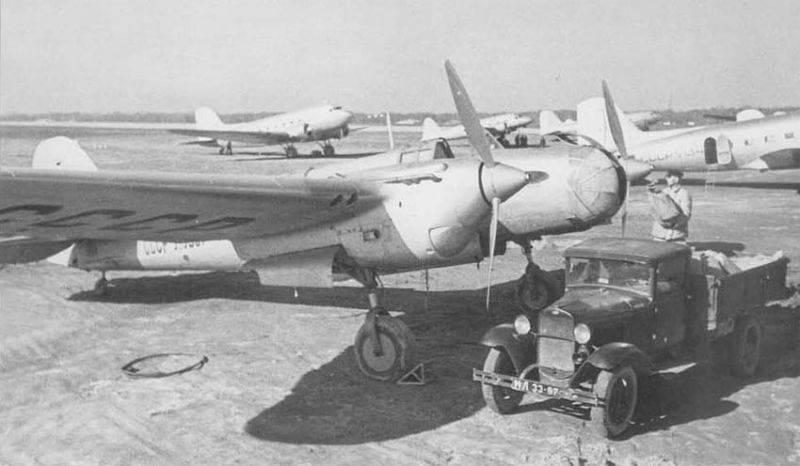
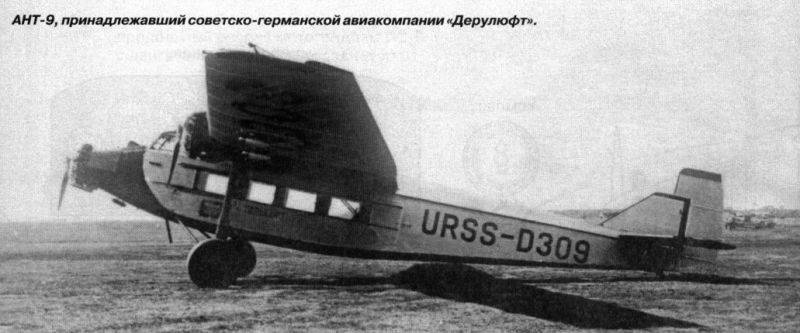
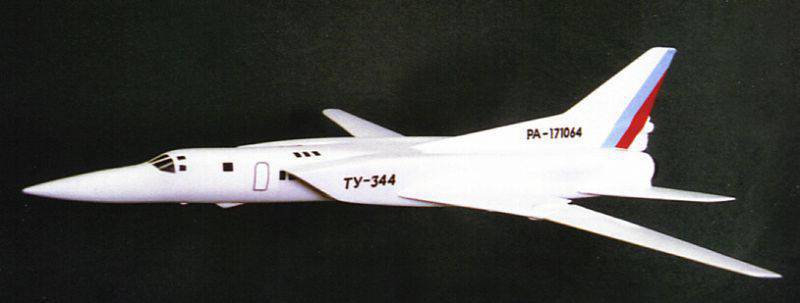
Information